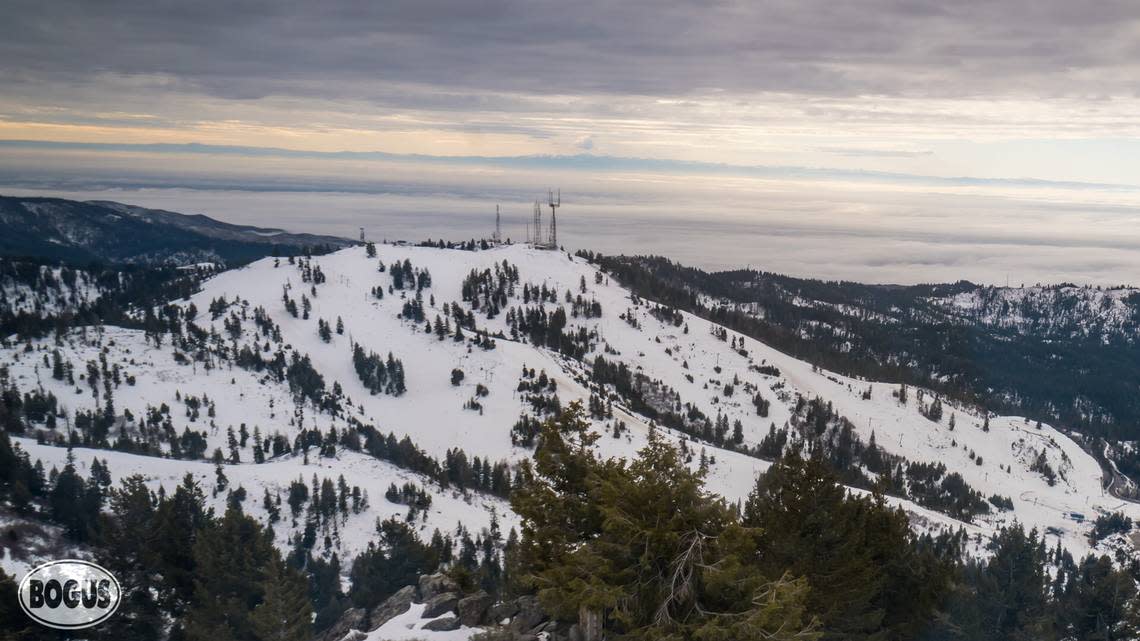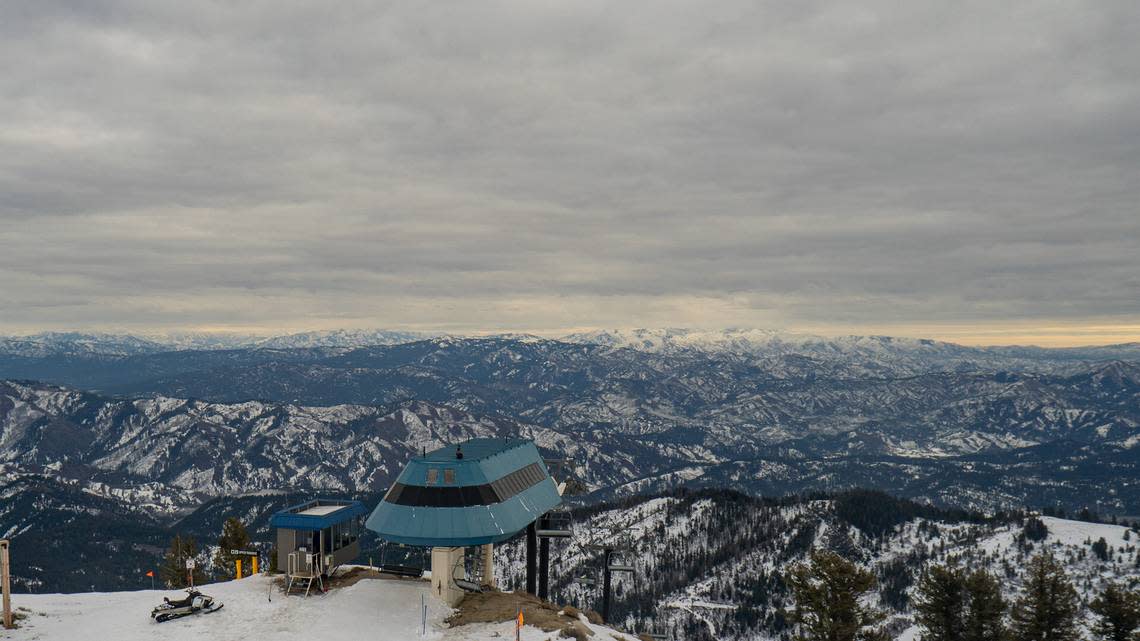‘Think cold’: Idaho ski areas embrace snowmaking as warm, dry winter leaves slopes sparse
Above the foggy layer of clouds shrouding Boise, the mountains at Bogus Basin ski area are white with snow — but just barely. In some spots, shrubs and grasses poke through the snow. In others, streaks of brown earth indicate where skiers and snowboarders have worn down the snowpack.
On Friday afternoon, Bogus’ snow markers, which show how many inches of snow have accumulated on the mountain, were completely bare. A thermometer at one station read 40 degrees, even warmer than Boise nearly 4,000 feet lower in elevation.
Bogus opened for the season on Nov. 25 with 100% machine-made snow — a first for the 80-year-old nonprofit. Like other local ski areas, it has been navigating a warm, dry start to winter that meteorologists say is due to the El Niño atmospheric phenomenon.
With far less snow on the ground than in recent seasons, ski area officials said they’re relying heavily on snowmaking, something that could become the norm as climate change impacts average temperatures.
“We clearly would not be open right now without snowmaking,” Bogus Basin general manager Brad Wilson told the Idaho Statesman in an interview.
Warm winter weather challenges ski areas
Snow fell in Boise on Dec. 1 and dropped 2.7 inches. Then it stopped.
Boise has accumulated just 2.8 inches of snow since summer. The typical accumulation this time of year is 5.6 inches, according to Jaret Rogers, a meteorologist at the National Weather Service’s Boise office.
Ski areas across the region have seen similar weather: dustings of snow followed by periods of unseasonably warm temperatures. Data shows mountain areas in Southwest Idaho have only 60% to 70% of their average snowpack.
Rogers said a persistent high-pressure system has kept temperatures above average and prevented storm tracks from taking hold in the Northwest. A weekend storm promises little relief, with perhaps an inch of accumulation in the valley and 2 to 6 inches of snow in the mountains.
Wilson said the weather has been a “double whammy” for local ski areas. They’ve seen little natural snow and, while snowmaking has proved vital, warmer temperatures have prevented ski areas from making as much powder as they need.
“We have not had a night of snowmaking for two weeks, which is absolutely unheard of for this time of year,” Wilson told the Statesman.
He said it’s a stark contrast from last season, when Bogus delayed its closing date to May 6 after late-season storms dumped nearly 4 feet of snow.
Snowmaking key for finances, future
Like Bogus, Brundage Mountain in McCall and Tamarack Resort in Donnelly have snowmaking setups. The “snow guns” spray water into the air, and when temperatures are right, those water droplets crystallize and fall as snow. The practice has become increasingly popular at ski areas in recent years, and it can be a crucial stopgap when natural snow is sparse.
Wolfe Ashcraft, vice president of resort operations at Tamarack, told the Statesman the resort is seeing the impact of a warm winter with lower visitation. Those lean years can put a strain on ski areas as they lose not just lift ticket revenue but also income from rentals, lessons, concessions and other ancillary spending.
In 2014, El Niño conditions kept the Boise area so warm that Bogus Basin saw its latest season opener ever: Jan. 19. Wilson, who joined the resort the following year, said the season was devastating financially. Now the nonprofit’s coffers are in much better shape, but snowmaking offers extra peace of mind.
Wilson said Bogus plans to continue expanding its snowmaking system, which it launched in 2018.
“We’d love to go back in time to when it always snowed and you could open on Thanksgiving on natural snow, but that’s simply not the case with the climate crisis,” Wilson said, noting that Bogus’ snowmaking system runs on renewable energy purchased from Idaho Power.
“This (warmer weather) is going to be more typical, and we’re going to be ready for it,” he said.
Wilson, Ashcraft and Brundage spokesperson April Whitney said their ski areas are still looking forward to holiday crowds. Each mountain is offering a celebratory New Year’s event and anticipates adding fresh snow — natural or man-made — as temperatures cool in the coming days.
Whitney said it’s still early in the season, and springtime could see a completely different landscape depending on storm systems.
“We’re telling people to ‘think cold,’” she said.
Ashcraft said crews at Tamarack have been “creative” in how they groom the slopes, making the most of the snowfall. He encouraged skiers and snowboarders to head to the mountain even if conditions aren’t at their peak.
“The mountains are a beautiful place, and you get to spend time with your family and friends,” Ashcraft said. “You’re outdoors and in clean air. That hasn’t changed.”


